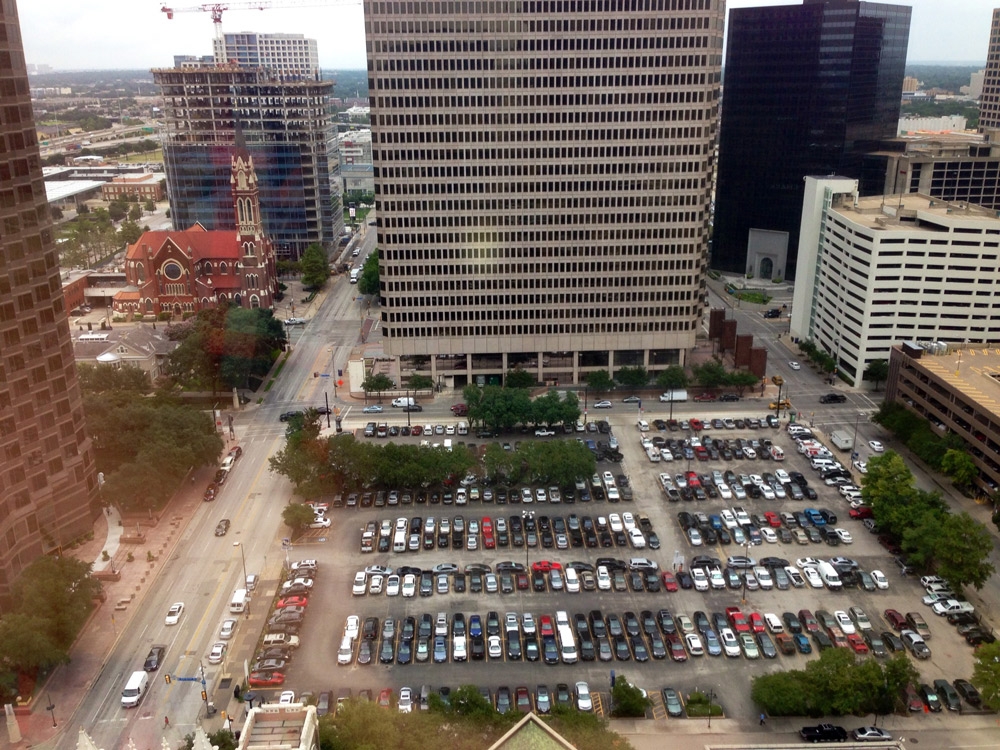You can’t write about Dallas — and downtown Dallas in particular — and not wrestle with the old problem of parking. As I pointed out just a few weeks ago, the dramatic change in the physical landscape of the urban center directly reflects the combination of economic, political, and social forces that have been instrumental in the past half-century in turning large swaths of downtown into space for cars. To reverse that trend, to try and figure out a way to make downtown the kind of walkable, inter-connected, pedestrian-friendly places that most people seek out in cities around the world, Dallas needs to figure out how to deal with its parking problems.
Of course, if figuring out parking was easy, Dallas — post-auto cities like it — would have figured out how to create effective policy and market incentives around parking decades ago. But parking is a lot more complicated planning topic than it might seem at first. To start, take the simple paradoxical relationship with downtown and parking that continues to play out today: there is both too much and too little parking downtown, depending on whether you are viewing the city center’s challenges from a urban design or an urban economics perspective.
This is all what makes The Economist magazine’s latest deep-dive into the world of urban parking such a fascinating read, even for a topic that is about as bland as tuna casserole at a Grand Rapids pot-luck. The Economist acknowledges this blandness off-the-bat, and attributes the boredom of the topic to the difficulty in dealing with it:
Parking can seem like the most humdrum concern in the world. Even planners, who thrill to things like zoning and floor-area ratios, find it unglamorous. But parking influences the way cities look, and how people travel around them, more powerfully than almost anything else. Many cities try to make themselves more appealing by building cycle paths and tram lines or by erecting swaggering buildings by famous architects. If they do not also change their parking policies, such efforts amount to little more than window-dressing. There is a one-word answer to why the streets of Los Angeles look so different from those of London, and why neither city resembles Tokyo: parking.
The Economist then looks at parking policy at cities around the world and isolates some of the seemingly contradictory rationales that surround the issue. Attitudes towards parking policy vary wildly from city-to-city and often reflect social attitudes and assumptions more than they do a cold, rational assessment of market forces. The simplest example is the term “free parking.” Parking is never free:
Free parking is not, of course, really free. The costs of building the car parks, as well as cleaning, lighting, repairing and securing them, are passed on to the people who use the buildings to which they are attached. Restaurant meals and cinema tickets are more pricey; flats are more expensive; office workers are presumably paid less. Everybody pays, whether or not they drive. And that has an unfortunate distributional effect, because young people drive a little less than the middle-aged and the poor drive less than the rich. In America, 17% of blacks and 12% of Hispanics who lived in big cities usually took public transport to work in 2013, whereas 7% of whites did. Free parking represents a subsidy for older people that is paid disproportionately by the young and a subsidy for the wealthy that is paid by the poor.
So how do you deal with it? The article doesn’t delve into enough specific examples to offer any substantive clues for Dallas as to a good way forward. But it does offer an example that shows how parking policy is often driven more by cultural attitudes than anything else. In Dallas, it can seem that when residents can’t find a spot within 50 feet of their destination, there is a perceived parking problem. But in a city like Tokyo, which has some of the strictest parking restrictions, the mere presence of cars parked on city streets can be baffling for residents.
There is, however, one exception to the rule that residential parking must never be subjected to market forces. In the 1950s, when it was still far from rich, Japan began to require city-dwellers who did not have parking spaces in their buildings to purchase them. These days anybody who wishes to buy a car must first show a receipt for a space. He or she had better use it: any vehicle without one left on the roadside will be removed by the police in the middle of the night.
Freed of cars, the narrow residential streets of Tokyo are quieter than in other big cities. Every so often a courtyard or spare patch of land has been turned into a car park — some more expensive than others. Takaomi Kondoh, who works for a firm that manages buildings and car parks, explains that prices are usually higher close to transport hubs, because commuters compete for those spaces. Near the central station in Tama, a suburb, the going rate is ¥17,000 per month ($150). Ten minutes’ walk away it drops to ¥10,000.
Once you become accustomed to the idea that city streets are only for driving and walking, and not for parking, it is difficult to imagine how it could possibly be otherwise. Mr Kondoh is so perplexed by an account of a British suburb, with its kerbside commons, that he asks for a diagram. Your correspondent tries to draw his own street, with large rectangles for houses, a line representing the kerb and small rectangles showing all the parked cars. The small rectangles take up a surprising amount of room.





